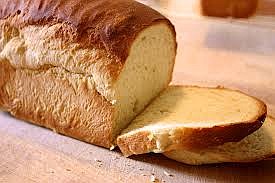Salt-free bread, the staff of life
December 1, 2014 at 8:52 a.m. | Updated December 1, 2014 at 8:52 a.m.
Salt is hiding everywhere. And it’s lurking in foods you eat often that don’t taste that salty.
One of the most significant sources of sodium in our diets is bread. Most bread has between 170 and 250 milligrams of salt per slice. If you have a bagel at breakfast (500 mg), a sandwich with two slices of bread (400 mg) for lunch, and a roll for dinner (200 mg), you will have consumed more than half of your recommended sodium intake for a day. Too much salt increases your risk of high blood pressure and heart and kidney disease.
Take care of yourself with the following tips to reduce salt in bread, bagels and rolls.
Shop wisely and read labels. Bread varieties vary a lot. Choose those with less sodium, like Ezekiel’s whole grain bread, Sarah Lee 45 calories bread, or Energy Foods’ gluten-free low-sodium breads.
Try “Sandwich Thins” type breads. Since they are thinner than regular bread, they are usually lower in sodium.
Use corn tortillas for a lunch wrap. They contain only 5-10 milligrams of sodium each.
If you buy bakery bread, which does not have a nutrition label, ask if nutrition information is available. If not, ask the bakery staff to request it from their vendors.
Buy small, snack-size bagels instead of the regular, big ones.
Make biscuits or muffins using low-sodium baking powder or low-sodium baking soda. You can find this at most health food stores, online or in some grocery stores.
Try baking your own low-sodium bread.
Making bread is fun and easy, and all you need are a few simple ingredients. Even if you only make your own bread occasionally, you will cut a lot of sodium from your diet when you do.
Here’s a quick and easy recipe using a fast-rise method. Watch the rising time carefully, since yeast works quickly without salt. On a warm day, this will take less time. Bread has risen when it still has a rounded appearance.
Salt-Free Bread
2 ½ -3 cups unsifted flour
1 tablespoon sugar
1 package dry yeast
1 cup very hot water
1 tablespoon oil
Mix 1 cup flour, sugar, and undissolved yeast in large mixer bowl. Add very hot water and oil and beat 2 minutes at medium mixer speed. Stir in the remaining 1 ½ to 2 cups flour until dough is no longer sticky. Turn out on lightly floured board and knead until smooth and elastic, about 5 minutes. Put dough in a greased bowl, then turn to grease the top of dough. Cover and let rise in a warm place until doubled in size, about 30 minutes. Fold dough down – don’t punch it. Shape into a loaf and put in a greased loaf pan for sandwich bread, or on a greased cookie sheet for a French-shaped loaf. Cover with a clean cloth and let rise another 30 minutes, or until doubled. Check often. Bake in a 400-degree oven for about 30 minutes or until done. Remove from pan or sheet and cool on wire rack.
Variations:
• Italian herb bread: add 1 teaspoon Italian seasoning and ½ teaspoon celery seeds with first cup of flour.
• Fresh rosemary bread: add ½ cup of finely chopped fresh rosemary with first cup of flour.
• Sweet bread: Knead in 1 cup raisins or chopped nuts with 1 teaspoon cinnamon.
• Dinner rolls: Spoon into greased muffin cups, fill half full. Let rise about 15 minutes, bake at 425 degrees for 10-15 minutes.
• Cinnamon rolls: Shape dough into rectangle. Brush with salt-free melted butter, sprinkle with mixture of ¼ cup sugar and 1 teaspoon cinnamon. Roll up jelly-roll style. Cut sections off and place in greased muffin tins or in a 9x9” greased pan.
• Streusel coffee cake: After dough rises, pat to fit into greased round or square pan. Sprinkle streusel topping (1/3 cup flour, 1/3 cup sugar, 3 tablespoons salt-free butter). Cover and let rise until it doubles in size. Bake at 400 degrees for 25-30 minutes.
• Half whole wheat bread: Start with 1 cup white flour, and use whole wheat flour for the rest. You can add ½ cup rolled oats, cracked wheat, or any other whole grain or seeds.
Nutritional information per slice:
Calories: 67 calories; Sodium: 1 mg; Protein: 2.3 gm
Salt-Free Bagels
2/3 cup warm water
1 package dry yeast
2 tablespoon sugar
3 tablespoon oil
2 eggs, beaten (1 for brushing over bagels)
2 1/2 -3 cups sifted flour
1 tablespoon caraway seeds or onion powder (optional)
Pour 1/3 cup warm water into small bowl. Stir in yeast. Let stand. In large bowl, mix 1/3 cup water, sugar, oil and 1 egg. Add yeast to egg mixture. Add flour gradually and mix well. Turn onto floured board. Knead for 5-8 minutes, until dough is satiny. Add more flour if needed. Put in greased bowl, turning to grease the top. Cover with clean towel and let rise until it doubles in size, about 30 minutes. About 10 minutes before it has fully risen, start heating a large pot of water on stove. Divide dough into 12 portions. Form into ropes of ¾ inch in diameter and form rings. Drop into boiling water. Cook for 2-3 minutes until bagels rise to top. Place on greased cookie sheet. Brush with 1 egg and 1 tablespoon water mixture. Sprinkle with poppy or sesame seeds or onion powder as desired. Bake in preheated 400-degree oven until brown, about 20 minutes.
Nutritional information per bagel:
Calories: 146; Sodium: 12mg; Protein 3.8 gm
The recipes in this column are meant for people who want to keep their kidneys healthy and blood pressure down by following a low-sodium diet. In most cases, except for dialysis patients, a diet high in potassium is thought to help lower high blood pressure. These recipes are not intended for people on dialysis without the supervision of a registered dietitian.
[Katy G. Wilkens is a registered dietitian and department head at Northwest Kidney Centers. She has a Master of Science degree in nutritional sciences from the University of Washington. See more of her recipes at www.nwkidney.org.]





